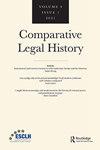The Art of Law: artistic representations and iconography of law and justice in context, from the middle ages to the first world war
IF 0.5
Q2 LAW
引用次数: 0
Abstract
The ambitions of The Art of Law are substantial. The subtitle – ‘Artistic Representations and Iconography of Law and Justice in Context, from the Middle Ages to the First World War’ – makes plain the breadth of the aspirations. The editors brought together European legal historians, art historians and semioticians to explore the import of shared and overlapping visual traditions. The introduction explains that the book grew out of an art exhibition held in Bruges, the site of the extraordinary 1498 Gerard David painting of the Judgment of Cambyses, and discussed in Chapters Two and Seven. The story comes from the Historiae, written by Herodotus around 440 BCE and describing the rule of King Cambyses, said to have lived some hundred years earlier. According to Herodotus, upon learning that the judge, Sisamnes, was corrupt, Cambyses ordered him flayed alive. Thereafter, Cambyses appointed Otanes, the son of Sisamnes, to serve as a jurist and forced the son to preside on a seat made from the skin of his father. From the thirteenth century onward, versions of this narrative were reiterated in European compilations of classical stories and, by the seventeenth century, regularly portrayed in European town halls. Dozens of images exist, but the vividness of the Judgment of Cambyses by the Flemish artist David is noteworthy. Competing interpretations exist of both the Cambyses story and the reasons for its法律艺术:从中世纪到第一次世界大战,法律与正义的艺术表现和图像
《法律的艺术》的野心是巨大的。副标题是“中世纪到第一次世界大战背景下法律与正义的艺术表现和肖像”,这清楚地表明了作者的抱负之广。编辑们将欧洲法律史学家、艺术史学家和符号学家聚集在一起,探讨共享和重叠视觉传统的重要性。该书的引言解释说,该书源于在布鲁日举行的一次艺术展览,这里是1498年杰拉德·大卫(Gerard David)非凡的画作《冈比西斯的审判》(Judgment of cambses)的所在地,并在第二章和第七章中进行了讨论。这个故事出自希罗多德在公元前440年左右写的《历史》,描述了据说生活在几百年前的冈比西斯国王的统治。根据希罗多德的说法,冈比西斯在得知法官西塞姆尼斯腐败后,下令将他活活剥皮。此后,冈比西斯任命西塞姆尼斯的儿子奥坦尼斯担任法学家,并强迫儿子坐在用他父亲的皮肤制成的座位上。从13世纪开始,这种叙述的版本在欧洲的经典故事汇编中反复出现,到17世纪,在欧洲的市政厅中经常被描绘出来。虽然有几十幅图像,但佛兰德艺术家大卫的《冈比西斯的审判》的生动程度值得注意。对冈比西斯的故事及其原因存在着不同的解释
本文章由计算机程序翻译,如有差异,请以英文原文为准。
求助全文
约1分钟内获得全文
求助全文
来源期刊
CiteScore
1.70
自引率
0.00%
发文量
20
期刊介绍:
Comparative Legal History is an international and comparative review of law and history. Articles will explore both ''internal'' legal history (doctrinal and disciplinary developments in the law) and ''external'' legal history (legal ideas and institutions in wider contexts). Rooted in the complexity of the various Western legal traditions worldwide, the journal will also investigate other laws and customs from around the globe. Comparisons may be either temporal or geographical and both legal and other law-like normative traditions will be considered. Scholarship on comparative and trans-national historiography, including trans-disciplinary approaches, is particularly welcome.

 求助内容:
求助内容: 应助结果提醒方式:
应助结果提醒方式:


